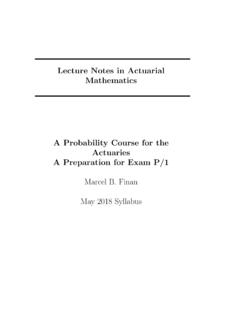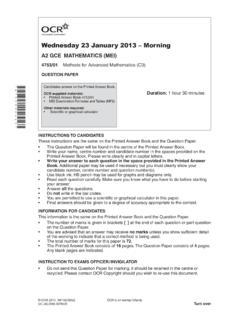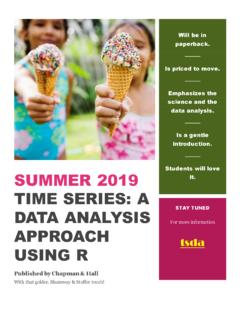Transcription of Additional Problems Lie Groups, Applications
1 Additional Problems for Groups, Lie Groups, Lie Algebras with Applications by Willi-Hans Steeb International School for Scientific Computing at University of Johannesburg, South Africa Igor Tanski International School for Scientific Computing Yorick Hardy Department of Mathematical Sciences at University of South Africa, South Africa updated: February 8, 2017. Preface The purpose of this manuscript is to supply a collection of Additional prob - lems for the book : Problems and Solutions for Groups, Lie Groups, Lie Algebras and Applications . World Scientific Publishing, Singapore 2012. ISBN: 13-978-981-4383-90-5. Accompanying problem books for this book are: Problems and Solutions in Introductory and Advanced Matrix Calculus by Willi-Hans Steeb World Scientific Publishing, Singapore 2006.
2 ISBN 981 256 916 2. Problems and Solutions in Quantum Computing and Quantum Informa- tion, third edition by Willi-Hans Steeb and Yorick Hardy World Scientific, Singapore, 2006. ISBN 981-256-916-2. The International School for Scientific Computing (ISSC) provides certifi- cate courses for this subject. Please contact the author if you want to do this course or other courses of the ISSC. e-mail addresses of the authors: Home page of the authors: v vi Contents Preface v Notation ix 1 Groups 1. 2 Lie Groups 15. 3 Lie Algebras 21. 4 Applications 32. 5 Programming Problems 55. Bibliography 59. Index 68. vii ix Notation := is defined as belongs to (a set).. / does not belong to (a set). T S subset T of set S. S T the intersection of the sets S and T. S T the union of the sets S and T.
3 Empty set N set of natural numbers Z set of integers Q set of rational numbers R set of real numbers R+ set of nonnegative real numbers C set of complex numbers Rn n-dimensional Euclidean space space of column vectors with n real components Cn n-dimensional complex linear space space of column vectors with n complex components H Hilbert space i 1. <z real part of the complex number z =z imaginary part of the complex number z |z| modulus of the complex number z |x + iy| = (x2 + y 2 )1/2 , x, y R. f (S) image of the set S under the mapping f f g composition of two mappings (f g)(x) = f (g(x)). G group Z(G) center of the group G. Zn cyclic group {0, 1, .. , n 1}. under addition modulo n G/N factor group Dn nth dihedral group Sn symmetric group on n letters, permutation group An alternating group on n letters, alternating group L Lie algebra x column vector in the vector space Cn xT transpose of x (row vector).
4 0 zero (column) vector norm x x y x y scalar product (inner product) in Cn x y vector product in R3. S2 two sphere A, B, C m n matrices det(A) determinant of a square matrix A. tr(A) trace of a square matrix A. rank(A) rank of a matrix A. AT transpose of the matrix A. A conjugate of the matrix A. A conjugate transpose of matrix A. A conjugate transpose of matrix A. (notation used in physics). A 1 inverse of the square matrix A (if it exists). In n n unit matrix I unit operator 0n n n zero matrix AB matrix product of an m n matrix A. and an n p matrix B. [A, B] := AB BA commutator of square matrices A and B. [A, B]+ := AB + BA anticommutator of square matrices A and B. A B Kronecker product of matrices A and B. A B Direct sum of matrices A and B. jk Kronecker delta with jk = 1 for j = k and jk = 0 for j 6= k eigenvalue real parameter t time variable H Hamilton operator N Number operator g metric tensor field real parameter exterior product d exterior derivative The Pauli spin matrices are used extensively in the book .
5 They are given by . 0 1 0 i 1 0. x := , y := , z := . 1 0 i 0 0 1. In some cases we will also use 1 , 2 and 3 to denote x , y and z . Chapter 1. Groups problem 1. Can one find a commutative group with 5 elements such that each element is inverse to itself? problem 2. Show that S3 is isomorptic to the dihedral group of order 6. problem 3. Find all solutions of z 5 = 1. Show that the solutions form a group under multiplication. Find all subgroups. Add all the elements of the solution. Discuss. problem 4. Let z C and z 6= 0. (i) Do the 2 2 matrices . z 0 0 z , 0 z 1 z 1 0. form a group under matrix multiplication? (ii) Do the 3 3 matrices . z 0 0 0 0 z 0 1 0 , 0 1 0 . 0 0 z 1 z 1 0 0. form a group under matrix multiplication? problem 5. Let H1 , .. , Hn be subgroups of the group G.
6 Show that the intersection of subgroups Hj of a group G for j J := {1, 2, .. , n} is again a subgroup of G. 1. 2 Problems and Solutions problem 6. Let G be a group. Given two elements g1 , g2 G. One defines the group commutator of g1 and g2 to be the element g1 1 g2 1 g1 g2 . Consider the Lie group SO(1, 1, R) with . cosh sinh cosh sinh . g1 ( ) = , g1 ( ) = . sinh cosh sinh cosh . Find the group commutator. problem 7. Show that the set of the 8 quaternions M := { 1, i, j, k }. with the composition i2 = j 2 = k 2 = 1, ij = k, ji = k form a group, where 1 is the identity element. problem 8. (i) Write down all six 3 3 permutation matrices which form a group under matrix multiplication. Find all the eigenvalues of these matrices. Do they form a group under multiplication? (ii) Find the three normalized eigenvectors for each of the permutation matrices.
7 Then for each of them form a 3 3 unitary matrix by inserting the normalized eigenvectors as column vectors in the matrix. Do these six unitary matrices form a group under matrix multiplication? Obviously for the identity matrix we find the identity matrix again. problem 9. Let = exp(i2 /3). Consider the matrices . 1 0 0 0 0 1. A = 0 0 , B = 1 0 0 . 0 0 2 0 1 0. (i) Show that the matrices A, A2 , A3 form a group under matrix multipli- cation. (ii) Show that the matrices B, B 2 , B 3 form a group under matrix multipli- cation. (iii) Do the matrices Aj B k (j, k = 1, 2, 3) form a group under matrix mul- tiplication? (iv) Do the matrices Aj B k (j, k = 1, 2, 3) form a group under matrix multiplication? Groups 3. problem 10. Consider the group Sn . Any element of Sn can be written as a product of disjoint cycles, and two elements of Sn are conjugate if and only if they have the same number of cycles of any given length.
8 Thus, a conjugacy class of Sn can be specified by giving an unordered partition of the number n. We write a partition of n as a tuple = ( 1 , 2 , , k ), where i=n X. i = n i=1. and 1 2 k > 0. We can also express such a partition pictorially using a Young diagram, which is a series of rows of boxes, in which the i-th row contains i boxes. For example, the partition (5, 4, 1, 1). of 11 can be represented by the following Young diagram. x x x x x x x x x x x A numbering of the Young diagram is a labeling of the boxes by the numbers 1, 2, .. , n. For instance, we can number the diagram by 2 5 1. 4 3. There are n! such numberings. There is an action of Sn on the set of numberings by permuting the numbers. A tabloid is an equivalence class of numberings of , where we consider two numberings T and T 0 equivalent if the entries of each row of T and T 0 are the same.
9 For instance, we have 2 5 1 1 2 5. =. 4 3 3 4. We denote by {T } the tabloid corresponding to T . There is an action of Sn on the set of tabloids of shape by {T } = { T }. We now define M . to be the complex vector space with basis the tabloids of shape , and we let Sn act by permuting the basis elements. (i) Consider tabloids of shape (n 1, 1). What is the dimension of M in this case? How Sn acts in this space? (ii) Consider tabloids of shape (1, .. , 1). What is the dimension of M in this case? How Sn acts in this space? problem 11. Let G be a group. An automorphism of G is an isomorphism sending G onto itself. Show that the set Aut(G) of automorphisms of G is a group with respect to the operation of composition of automorphisms. 4 Problems and Solutions problem 12. Do the four 4 4 matrices 1 0 0 0 0 0 1 0.
10 0 1 0 0 0 0 0 1 . I4 = , B= . 0 0 1 0 1 0 0 0.. 0 0 0 1 0 1 0 0. 0 0 0 1 0 1 0 0.. 0 0 1 0 1 0 0 0 . C= , D= . 0 1 0 0 0 0 0 1.. 1 0 0 0 0 0 1 0. form a group under matrix multiplication? Can the matrices be written as the Kronecker product of two 2 2 permutation matrices? problem 13. Let V be a vector space over a field F. Let W be a subspace of V . We define an equivalence relation on V by stating that v1 v2 if v1 v2 W . The quotient space V /W is the set of equivalence classes [v]. where v1 v2 W . Thus we can say that v1 is equivalent to v2 modulo W. if v1 = v2 + w for some w W . Let . 2 x1. V =R = : x1 , x2 R. x2. and . x1. W = : x1 R . 0. (i) Is . 3 1 4 3 3 4. , , ? 0 0 1 1 0 1. (ii) Give the quotient space. problem 14. Consider the set G = { (a, b) R2 : < a < , 0 b < 2 }.









